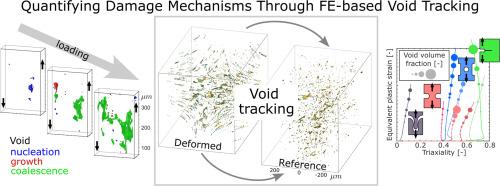Quantifying Damage Mechanisms Through FE-based Void Tracking: Application to Shear and Tension In-situ Laminography Experiments on AA2198-T851
IF 8.3
1区 材料科学
Q1 MATERIALS SCIENCE, MULTIDISCIPLINARY
引用次数: 0
Abstract
This study presents a hybrid experimental-numerical postprocessing technique for analyzing damage evolution during in-situ tomography experiments. Using the displacement fields obtained from finite-element (FE) simulations as initial guesses, voids are tracked throughout loading by mapping their centroids to the initial configuration with a novel void tracking algorithm. This algorithm facilitates differentiation between void nucleation, growth and/or coalescence of existing voids. In-situ laminography experiments are performed on flat shear, central-hole tension, notched tension and compact tension specimens extracted from recrystallized aluminum alloy 2198-T851. The specimens are monotonically loaded all the way to fracture to gain insight into ductile failure mechanisms for predominantly biaxial stress states. Detailed 3D gray scale images are acquired at multiple stages of each experiment, allowing distinguishing between polycrystalline matrix, inter-metallic particles and voids at sub-micrometer resolution. The postprocessing of all experiments leads to a wealth of experimental data on void sizes, shapes, counts, volume fractions, and mechanisms of origin. Average stress states and macroscopic strain estimates are derived using continuum scale FE simulations with an anisotropic non-porous plasticity model and related to the void evolution. The tomographic observations show two primary damage mechanisms at early plastic straining stages: (1) intermetallic particle cracking and debonding, and (2) micro-crack emergence mainly at grain boundaries. At high plastic straining stages, grain boundary unzipping leads to fracture via micro-crack growth and coalescence, more prevalent under generalized shear than tension. It is found that particle-related void growth is slow and enhances the material's macroscopic ductility by delaying the growth of large voids.

求助全文
约1分钟内获得全文
求助全文
来源期刊

Acta Materialia
工程技术-材料科学:综合
CiteScore
16.10
自引率
8.50%
发文量
801
审稿时长
53 days
期刊介绍:
Acta Materialia serves as a platform for publishing full-length, original papers and commissioned overviews that contribute to a profound understanding of the correlation between the processing, structure, and properties of inorganic materials. The journal seeks papers with high impact potential or those that significantly propel the field forward. The scope includes the atomic and molecular arrangements, chemical and electronic structures, and microstructure of materials, focusing on their mechanical or functional behavior across all length scales, including nanostructures.
 求助内容:
求助内容: 应助结果提醒方式:
应助结果提醒方式:


